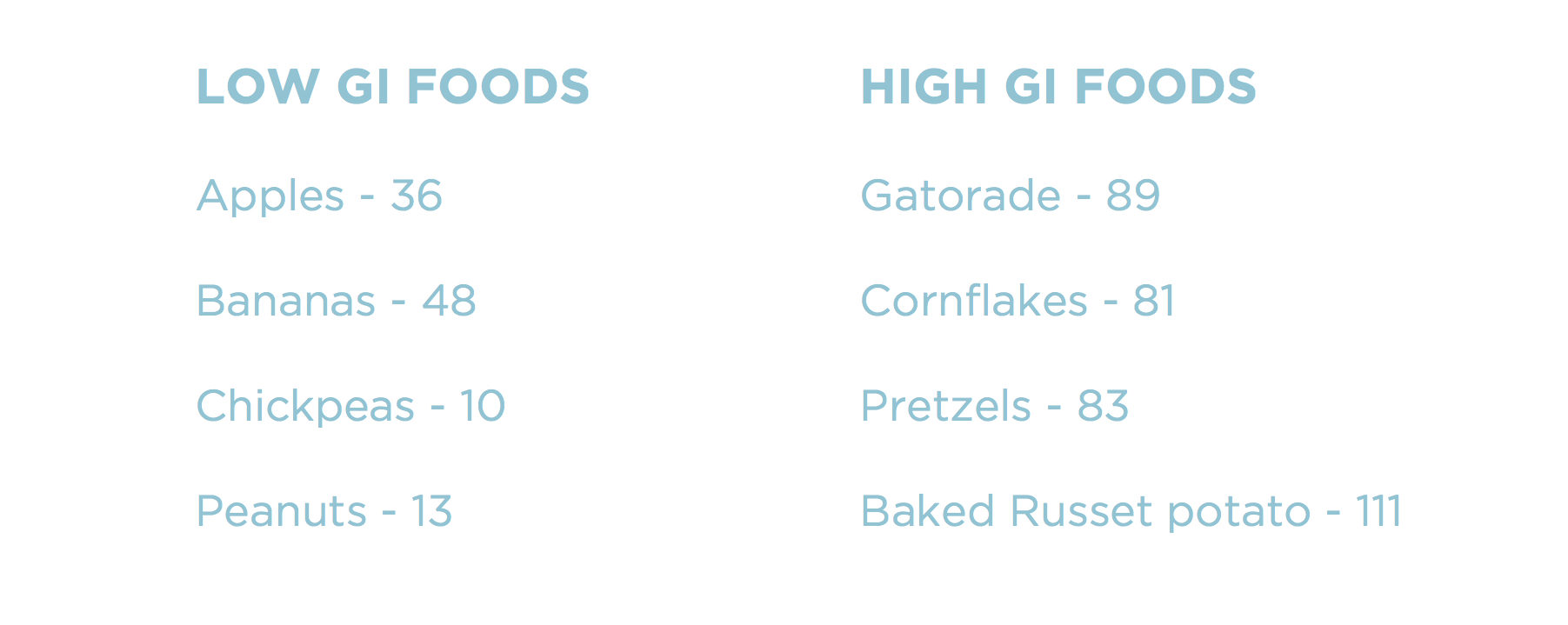You may be seeing the acronym GI floating around food stores and labels alike. Though being proceeded by ‘Joe” would be an inappropriate marking to find in a grocery store, the obvious question then, is: “Well what else would it mean?” That’s a great question. And instead of being proceeded, this particular label is preceded by the likes of ‘low’ or ‘high’ and stands for Glycemic Index.
Okay, so low or high glycemic index, what the heck is that? That’s another fantastic question and today, we’re going to break it down as easy as your body breaks down honey, and tell you why it’s important!
Glycemic Index (GI) is a relative ranking of carbohydrates in food by the ability to raise blood glucose levels. More simply put: The GI is a value that measures how carb-containing foods influence blood sugar levels. The higher the GI rank, the higher blood glucose levels will rise. Imagine a graph with a sharp peak. Lower GI foods cause blood glucose levels to be raised and lowered more gradually with a graph the looks more similar to a rolling hill:

Foods are ranked on a scale of 0 to 100 and are classified into three groups. A Low GI has a score of 55 or less. A moderate GI is between 56 and 69 and a high GI ranking includes 70 and above.
How is Glycemic Index measured?
In order to figure out the GI number of each food, healthy volunteers have their blood sugar tested during a fasting period and then at timed intervals following consumption of the specific food carbohydrate in question. The results are compared against results from a standardized reference food, usually glucose or white bread, for each participant, and the glycemic index is calculated.
What contributes to the body’s blood sugar response?
Glycemic Index measurements are individual in nature, but the glycemic response of the body can be affected by several factors; namely the type of sugar, as well as the presence and amount of fiber, fat and protein. Sugars can differ by their molecular make up and these differences impact how our bodies metabolize carbohydrates. Fructose, for example, the natural sugar found in fruits, has a lower rise in blood glucose response than other common carbohydrates.
While not all low GI foods have a high fiber content, it has been shown that low GI, high-fiber diets have had positive effects on preventing disease and may result in lower post-meal glucose response. Foods with a lower GIs are typically rich in fiber, protein, and/or fat. The rate of digestion slows when adding fiber, protein and fat to food intake, so the carbohydrate effect on blood glucose lowers as a result. However, there are foods considered to have a low GI that don’t have high amounts of protein, fat or fiber and conversely, high GI foods that do contain nutritional benefits. Watermelon, for example, has a GI around 72, but the amount of watermelon you would need to eat to equal the standard 50 grams of carbohydrate required for testing is much more than you would have in a single serving!
Side note: Thinking of this watermelon example, I would be amiss not to mention the related concept of Glycemic Load. Glycemic Load (GL) differs slightly from the GI by taking into consideration the amount of carbohydrate in a regular serving size of each food. Glycemic Load uses the Glycemic Index to calculate a new number which exemplifies the carbohydrate content related to portion size, reducing the kind of error seen in the previous example. So while watermelon is technically high on the GI scale, it is low in its glycemic load.
Ready for examples?:

Check out a more detailed glycemic index list of common foods published on Harvard Medical School’s website for a more comprehensive look at foods in your daily diet.
So, why does it matter?
Low GI foods may have a positive impact on eating choices by increasing satiety or feelings of fullness, and weight loss or control, as well as improve insulin resistance and glucose levels for people with type 2 diabetics. While knowing the exact Glycemic Index numbers may not be necessary, and because they do vary, an easy way to estimate the blood glucose effects that foods may have on the body is to focus on whole foods that include fiber, healthy fats, and a source of protein. The benefits of choosing nutrient-dense foods from a variety of food sources are plentiful, and using Glycemic Index as one tool may be a beneficial addition.
____________
Sources:
Academy of Nutrition and Dietetics. Nutrition Care Manual. Glycemic index. https://www.nutritioncaremanual.org/topic.cfm?ncm_toc_id=272751. Accessed January 16, 2018.
Bantle, J. P. (2006). Is fructose the optimal low glycemic index sweetener? Nestle Nutrition Institute Workshop Series: Clinical & Performance Program, (11), 83-91.
Eleazu, C. O. (2016). The concept of low glycemic index and glycemic load foods as panacea for type 2 diabetes mellitus; prospects, challenges and solutions. African Health Sciences, 16(2), 468–479. http://doi.org/10.4314/ahs.v16i2.15
Glatter, R. (2014, March 17). Benefits of a low glycemic approach to eating. Retrieved from https://www.forbes.com/sites/robertglatter/2014/03/17/benefits-of-a-low-glycemic- approach-to-eating/#7c3b08316fa3
Kimball, M. (2017, October 18). What is the glycemic index? Retrieved from https://www.eatright.org/food/nutrition/dietary-guidelines-and-myplate/what-is-glycemic-index
Mahan, L. K., Escott-Stump, S., & Raymond, J. L. (2012). Krause’s Food & the Nutrition Care Process (13th Edition). St. Louis, MO: Elsevier
Riccardi, G., Rivellese, A. A., & Giacco, R. (2008). Role of glycemic index and glycemic load in the healthy state, in prediabetes, and in diabetes. The American Journal of Clinical Nutrition, 87(1), 269S-274S.
Want more health hacks and wellness insights? We got you covered. You'll also receive a code for 15% off your first order!


Great read! This article really gave me a better understanding about glycemic index. Thanks a lot for posting!
Hi there – Thanks for giving this one a read! Glad to hear you learned something new.